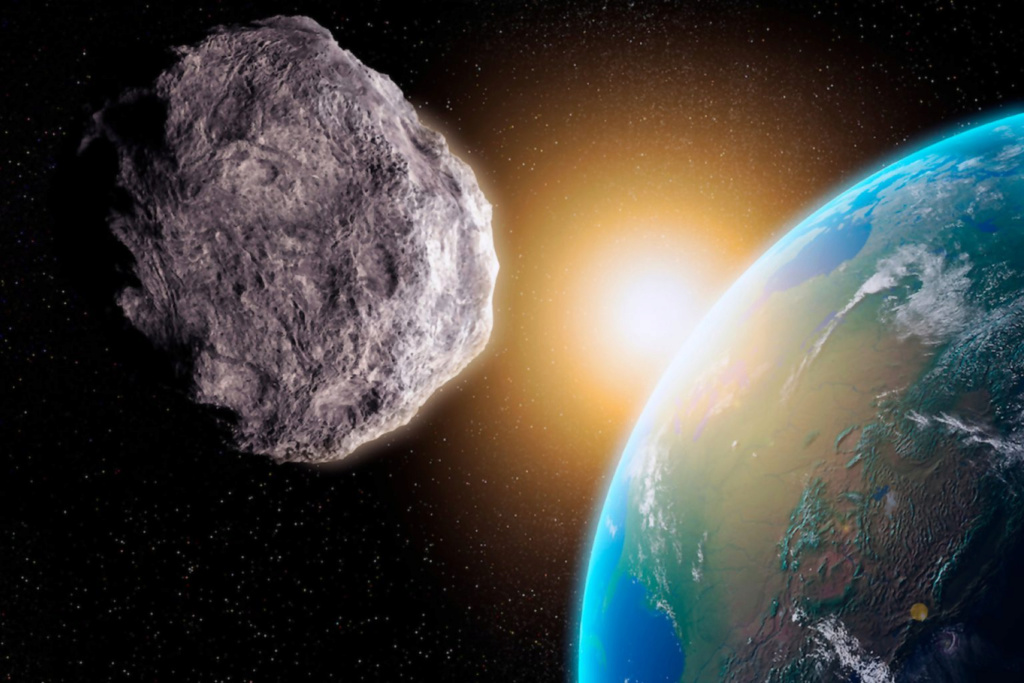The discovery of a new impact crater .. coinciding with the asteroid collision that caused the extinction of the dinosaurs

66 million years ago, before the Cretaceous and Paleogene, the collision of the asteroid “Chicxulub” with Earth caused one of the most important extinction events in the history of the Earth; It is the extinction of the dinosaurs, which is the largest confirmed collision event.
Frequent collisions
Although dangerous objects about 50 meters in diameter collide with the Earth approximately every 900 years, and those larger than one kilometer in size (which cause catastrophic regional or global consequences) about every million years; Only a small percentage of the effects of these hypervelocity impacts have been discovered or preserved, and there are close to 200 confirmed craters on Earth.
Since most of the Earth's surface (currently 71%) is covered by water, it is logical that marine impact craters constitute the majority of craters on Earth.
However, only 15 to 20 hypervelocity impact craters have been discovered in the seas, most of which are found in shallow continental seas, and most of them are now exposed onshore and only partially preserved.
Now, scientists have found evidence of an asteroid impact crater under the North Atlantic Ocean 8.5 kilometers wide, buried 300-400 meters below sea level, 400 kilometers off the coast of Guinea, West Africa.
The research team published its findings in the journal Science Advances on August 17.
The press release published on the Heriot-Watt University website in Edinburgh, UK, states that the team believes that the crater was caused by the collision of an asteroid 400 meters wide with Earth about 66 million years ago, which is around the same time that the Chixulub asteroid struck the Earth and wiped out the dinosaurs. However, they will need to dig into the sea floor and collect samples to prove their theory.

The collision of the asteroid Chixulub caused the extinction of the dinosaurs 66 million years ago (University of Texas)
Seismic data behind the detection
The press release also states that Heriot-Watt University geologist Dr. Osden Nicholson found the crater by seismic examination of the Atlantic Ocean floor. “I've interpreted a lot of seismic data, but I've never seen anything like this before," he explains. Instead of the many flat sediments I was expecting, I found a depression 8.5 km below the sea floor, with very unusual properties.”
"It has special features that point to an asteroid," he added. It has a raised rim and a very prominent central patch, which is consistent with large impact craters.”
Nicholson continues, “It also has what looks like ballistics coming out of the crater, with dispersed sediments extending tens of kilometers outside the crater. These characteristics are inconsistent with other forms of crater formation such as salt clouds or volcanic collapse,” Nicholson called the “Nadir Crater,” after a nearby seamount.
The statement also states that seismic data indicate that the age of the crater is the same as the age of the Chixulub crater that killed the dinosaurs, and the team believes that the asteroid that created the Nadir crater may have been formed due to the crash of a major asteroid or due to the flow of asteroids in that time period.
exciting discovery
“While it is a much smaller asteroid than the asteroid Chicxulub that caused the extinction of the dinosaurs, its very existence requires us to investigate the possibility of several collisions in the last Cretaceous period,” says Dr. Shane Gulick, a collision object expert at the University of Texas and a co-author of the research. Although 4 billion years have passed since the impacts that hit the Earth, only 200 craters have been discovered, so it is exciting to discover a new potential impact, especially in the marine environment that is difficult to explore.”

Simulations indicate that this crater was caused by the impact of an asteroid 400 meters wide (Heriot-Watt University)
The press release notes that the scientists used computer simulations to determine the type of collision that occurred and for possible effects.
“Our simulations indicate that this crater was caused by the impact of a 400-meter-wide asteroid in 500-800 meters of water, and likely caused a tsunami of higher height,” said Dr. Veronica J. Bray, a planetary scientist at the University of Arizona and co-author of the research. over a kilometer, plus a 6.5-magnitude earthquake or so.
In their paper, the researchers say that the seismic data allows them to build a framework for the approximate age of the crater and its ancient environment, and they use numerical models to simulate the impact event and test whether the geometry of the crater is compatible with the impact.
They also combine seismic observations and model results to build a hypothetical model of crater formation and the potential environmental consequences of such an event, taking into account the association of this potential collision with other Earth events of the same age.
"This is a preliminary simulation that still needs to be refined as we get more data, but it provides important new insights into the potential ocean depths in this region at the time of impact," Bray says.
Source: Websites

